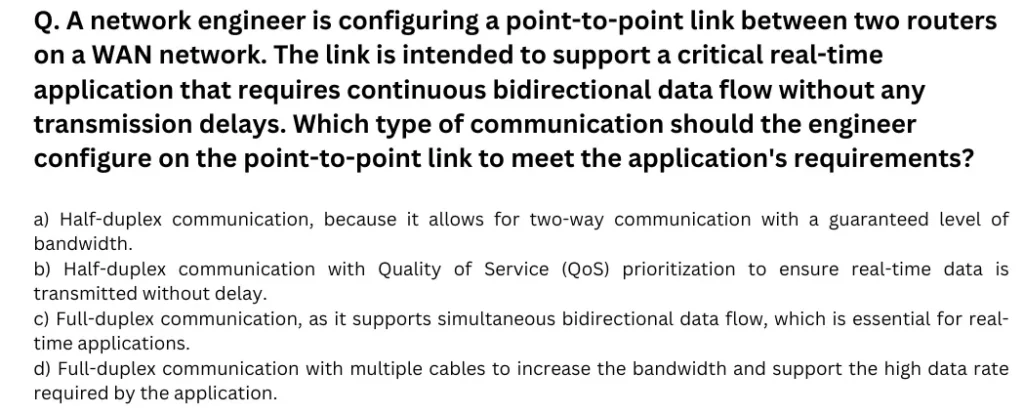Homework Help: Questions and Answers: A network engineer is configuring a point-to-point link between two routers on a WAN network. The link is intended to support a critical real-time application that requires continuous bidirectional data flow without any transmission delays. Which type of communication should the engineer configure on the point-to-point link to meet the application’s requirements?

a) Half-duplex communication, because it allows for two-way communication with a guaranteed level of bandwidth.
b) Half-duplex communication with Quality of Service (QoS) prioritization to ensure real-time data is transmitted without delay.
c) Full-duplex communication, as it supports simultaneous bidirectional data flow, which is essential for real-time applications.
d) Full-duplex communication with multiple cables to increase the bandwidth and support the high data rate required by the application.
Answer:
First, let’s understand the requirements and types of communication:
- Critical real-time application: Requires continuous bidirectional data flow without transmission delays.
- The link is point-to-point, which means it is a direct connection between two routers.
Half-duplex communication:
- Allows communication in both directions but not simultaneously.
- One device must wait for the other to finish transmitting before it can send its data.
- This can introduce delays, which is not suitable for real-time applications.
Full-duplex communication:
- Allows simultaneous communication in both directions.
- No waiting period, which ensures smooth and continuous data flow.
- This is ideal for real-time applications requiring continuous bidirectional communication.
Given Options: Step by Step Answering
a) Half-duplex communication, because it allows for two-way communication with a guaranteed level of bandwidth.
- Half-duplex communication” allows two-way communication, but it introduces delays as it does not allow simultaneous data flow.
- This is incorrect because it does not meet the requirement for simultaneous bidirectional data flow.
b) Half-duplex communication with Quality of Service (QoS) prioritization to ensure real-time data is transmitted without delay.
- “Half-duplex communication with QoS” still has the fundamental limitation of half-duplex, meaning it cannot transmit data simultaneously in both directions, leading to potential delays.
- This is incorrect for real-time bidirectional data flow.
c) Full-duplex communication, as it supports simultaneous bidirectional data flow, which is essential for real-time applications.
- “Full-duplex communication” allows for simultaneous bidirectional data flow, meeting the requirement for continuous real-time communication.
- This is correct, because as it supports the application’s need for simultaneous communication without delays.
d) Full-duplex communication with multiple cables to increase the bandwidth and support the high data rate required by the application.
- “Full-duplex communication with multiple cables” is overcomplicating the setup. A single full-duplex link is sufficient for continuous real-time communication, and adding extra cables does not necessarily address the core requirement.
- This is incorrect, since full-duplex alone is sufficient.
Final Answer
Based on the above analysis, the correct answer is:
c) Full-duplex communication, as it supports simultaneous bidirectional data flow, which is essential for real-time applications.
Full-duplex communication allows data to be sent and received simultaneously, which is crucial for the continuous bidirectional data flow required by the critical real-time application. It also minimizes transmission delays, meeting all the stated requirements.
Learn More: Homework Help
Q. Processor execution time can be reduced by which of the following?
Q. Why would a user want to compress a large file before sending it as an email attachment?